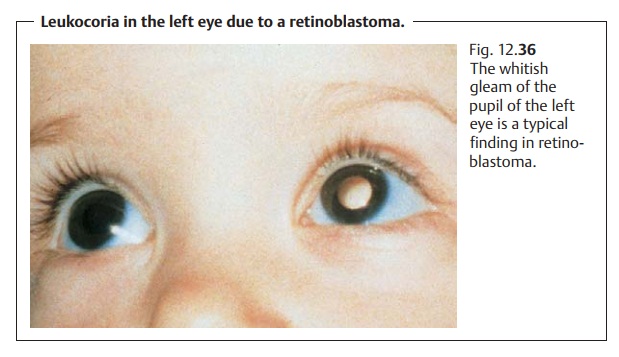Chapter: Ophthalmology: Retina
Retinoblastoma

Retinal Tumors and Hamartomas
Retinoblastoma
Definition
A retinoblastoma is a malignant tumor of early
childhood that develops from immature retinal cells.
Epidemiology:
Retinoblastoma is the most common malignant ocular tumorin
children, occurring in approximately one of 20000 births. In 30% of all cases,
it is bilateral.
Pathogenesis:
A somatic mutation is detected in about 95% of all patients.
Inthe other patients, it is inherited as an autosomal dominant trait. Changes
on chromosome 13q have been observed in germ-cell mutations. Retinoblas-tomas
may then occur at several locations in the retina or bilaterally.
Where retinoblastoma is inherited as an
autosomal dominant trait, the siblings of the affected child should be
regularly examined by an oph-thalmologist.
Symptoms:
Retinoblastoma manifests itself before the age of three in 90%
ofaffected children. Parents observe leukocoria (a whitish yellow pupil; Fig.
12.36) in 60% of these children,
strabismus in 20%, and a reddened eye in 10%.

Every child presenting with strabismus should
undergo examination of the fundus with the pupil dilated to exclude a
retinoblastoma.
Findings and diagnostic considerations:
A grayish white, vascularized reti-nal tumor
will be observed on ophthalmoscopy. In its advanced stages, this tumor was
formerly referred to as an amaurotic
cat's eye. Infiltration of the vitreous body, anterior chamber (pseudohypopyon),
and orbit may occur. A retinoblastoma that also involves the fellow eye and
pineal body is referred to as a trilateral
retinoblastoma.
A trilateral retinoblastoma is defined as
additional manifestation of the tumor in the pineal body.
Calcifications frequently occur in these
tumors. Radiographs or CT images that show calcifications can therefore help to
confirm the diagnosis in uncer-tain cases.
Differential diagnosis:
Several other disorders should be excluded by oph-thalmoscopy.
These include:
âť– Cataract (with leukocoria).
âť– Primary strabismus (with strabismus).
âť– Infection (with a reddened eye).
Retinal detachment, persistent hyperplastic
primary vitreous (PHPV), and Coats’ disease should also be excluded.
Treatment:
Tumors less than four pupil diameters may be managed
withradiation therapy delivered by plaques of radioactive ruthenium or iodine
(brachytherapy) and cryotherapy. Larger tumors require enucleation of the eye.
Prophylaxis:
Following the diagnosis, the fellow eye should be examinedwith
the pupil dilated every three months for five years. After that, follow-up
examinations may be performed at greater intervals.
Clinical course and prognosis:
Left untreated, a retinoblastoma will eventu-ally metastasize to
the brain and cause death. Patients frequently develop a second malignant tumor
such as an osteosarcoma.
Related Topics